Unfortunately there's no way to do this automatically yet. The easiest way would be to frame the diagram before finding the boundingRect. Since you're using the local units you just need to frame half the local width used in the diagram (add half of the line width used for the bounding rectangle if that has a line too).
Here's a simple example:
{-# LANGUAGE GADTs #-}
import Diagrams.Prelude
import Diagrams.Backend.Rasterific.CmdLine
main :: IO ()
main = mainWith $ frame 1 rects
rects :: Diagram B
rects = hsep 1 $ map (dia <>) [br1, br2, br3]
where
br1 = boundingRect dia # lwL 0.2 # lc red
br2 = boundingRect (frame 0.1 dia) # fc dodgerblue # lw none
br3 = boundingRect (frame 0.2 dia) # lwL 0.2 # lc red
dia :: Diagram B
dia = circle 3 # fc orange # lwL 0.2

A more general solution would be to draw the offset curves of each path using the local line width in the Diagram and find the bounding box of that. Diagrams.TwoD.Offset can almost do this but I don't think it works for all cases.
